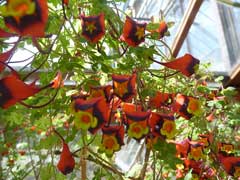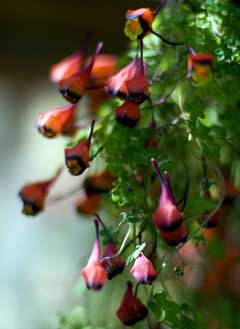 |
|
commons.wikimedia.org/wiki/User:Magnus_Manske |
 |
|
Translate this page:
Summary
Physical Characteristics

 Tropaeolum tricolorum is a PERENNIAL CLIMBER growing to 1.5 m (5ft).
Tropaeolum tricolorum is a PERENNIAL CLIMBER growing to 1.5 m (5ft).
See above for USDA hardiness. It is hardy to UK zone 8 and is frost tender. It is in flower from August to September. The species is hermaphrodite (has both male and female organs).
Suitable for: light (sandy), medium (loamy) and heavy (clay) soils and prefers well-drained soil. Suitable pH: mildly acid and neutral soils. It cannot grow in the shade. It prefers moist soil.
UK Hardiness Map
US Hardiness Map
Synonyms
Plant Habitats
Cultivated Beds;
Edible Uses
Edible Parts: Root
Edible Uses:
Tuber - cooked[177]. Small[200]. The round tubers are up to 6cm in diameter[260].
References More on Edible Uses
Medicinal Uses
Plants For A Future can not take any responsibility for any adverse effects from the use of plants. Always seek advice from a professional before using a plant medicinally.
None known
References More on Medicinal Uses
The Bookshop: Edible Plant Books
Our Latest books on Perennial Plants For Food Forests and Permaculture Gardens in paperback or digital formats.

Edible Tropical Plants
Food Forest Plants for Hotter Conditions: 250+ Plants For Tropical Food Forests & Permaculture Gardens.
More

Edible Temperate Plants
Plants for Your Food Forest: 500 Plants for Temperate Food Forests & Permaculture Gardens.
More

More Books
PFAF have eight books available in paperback and digital formats. Browse the shop for more information.
Shop Now
Other Uses
References More on Other Uses
Cultivation details
Requires a lime-free soil in a warm sunny position[1, 33, 200]. Prefers a turfy loam or a sandy peaty soil[1]. Requires a fairly dry summer after a moist winter and spring[260]. This is one of the easiest members of the genus to cultivate and usually produces new tubers quite freely[247]. This species is not very hardy when grown outdoors in Britain. The top growth will survive light frosts, whilst the tubers, if well mulched, will survive to at least -5°c[1, 200]. New tubers are not formed until late in the season (from September), so a mild autumn is required for good yields[33]. The tubers are formed very near the surface of the soil[90] and will require mulching to protect them from the cold if they are to be left in the ground during the winter[K]. The tubers can also be stored in a cool dry frost-free place over the winter and then planted out in April[200]. This species comes from a dry Mediterranean-type climate and commences growth in early autumn, growing through the winter then flowering in early summer before having a short dormancy in late summer[247]. Consequently, it is only going to succeed outdoors in the very mildest parts of the country and is generally best grown in a cold greenhouse[247, K]. The plant comes from an area with intermittent and unreliable rainfall. It is therefore adapted to remaining dormant for a number of years if the growing conditions are unsuitable and this habit sometimes manifests itself in cultivation, especially if the plants have been potted up recently[247]. A plant at Rosewarne Gardens in North Devon was about 2 metres tall and flowering profusely in late April 1995[K]. A climbing plant, it supports itself by twisting its leaf stalks around other plants etc[219]. The caterpillars of the cabbage white butterfly can be a nuisance and often cause considerable damage to the leaves[219].
References Carbon Farming Information and Carbon Sequestration Information
Temperature Converter
Type a value in the Celsius field to convert the value to Fahrenheit:
Fahrenheit:
The PFAF Bookshop
Plants For A Future have a number of books available in paperback and digital form. Book titles include Edible Plants, Edible Perennials, Edible Trees,Edible Shrubs, Woodland Gardening, and Temperate Food Forest Plants. Our new book is Food Forest Plants For Hotter Conditions (Tropical and Sub-Tropical).
Shop Now
Plant Propagation
Seed - sow early spring in a greenhouse. Prick the seedlings out into individual pots once they are large enough to handle and grow them on in the greenhouse for their first winter. Plant out in late spring or early summer, after the last expected frosts. The seed of cultivated plants is usually quite difficult to germinate, though wild-collected seed usually germinates freely[247]. Division of the tubers in the autumn or spring. In cold winter areas the tubers can be harvested in the autumn after top-growth has died down and they can then be stored in a cool frost-free position until planting them out in the spring. Cuttings of basal stems in the spring[200]. Pot them up into individual pots and place them in light shade in a frame until they are established. Plant out in early summer.
Other Names
If available other names are mentioned here
Native Range
Coming Soon
Weed Potential
Right plant wrong place. We are currently updating this section.
Please note that a plant may be invasive in one area but may not in your area so it's worth checking.
Conservation Status
IUCN Red List of Threatened Plants Status :

Growth: S = slow M = medium F = fast. Soil: L = light (sandy) M = medium H = heavy (clay). pH: A = acid N = neutral B = basic (alkaline). Shade: F = full shade S = semi-shade N = no shade. Moisture: D = dry M = Moist We = wet Wa = water.
Now available:
Food Forest Plants for Mediterranean Conditions
350+ Perennial Plants For Mediterranean and Drier Food Forests and Permaculture Gardens.
[Paperback and eBook]
This is the third in Plants For A Future's series of plant guides for food forests tailored to
specific climate zones. Following volumes on temperate and tropical ecosystems, this book focuses
on species suited to Mediterranean conditions—regions with hot, dry summers and cool, wet winters,
often facing the added challenge of climate change.
Read More
Expert comment
Author
Sw.
Botanical References
200
Links / References
For a list of references used on this page please go here
Readers comment
| Add a comment |
|
If you have important information about this plant that may help other users please add a comment or link below. Only comments or links that are felt to be directly relevant to a plant will be included. If you think a comment/link or information contained on this page is inaccurate or misleading we would welcome your feedback at [email protected]. If you have questions about a plant please use the Forum on this website as we do not have the resources to answer questions ourselves.
* Please note: the comments by website users are not necessarily those held by PFAF and may give misleading or inaccurate information.
To leave a comment please Register or login here All comments need to be approved so will not appear immediately.
|
Subject : Tropaeolum tricolorum
|
|
|
|